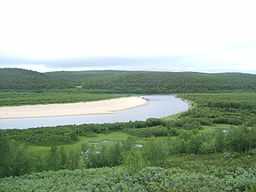Karasjohka
| Karasjohka (Kárášjohka) | |
| River | |
 View of the river | |
| Country | Norway |
|---|---|
| County | Finnmark |
| Municipalities | Karasjok, Kautokeino |
| Tributaries | |
| - left | Iešjohka |
| - right | Bávttajohka |
| Source | Nuorttit Rávdojávri lake |
| - location | Kautokeino, Finnmark, Norway |
| - elevation | 519 m (1,703 ft) |
| - coordinates | 68°43′56″N 24°15′18″E / 68.73222°N 24.25500°E |
| Mouth | Tana River |
| - location | Karasjok, Finnmark, Norway |
| - elevation | 125 m (410 ft) |
| - coordinates | 69°26′03″N 25°48′13″E / 69.43417°N 25.80361°ECoordinates: 69°26′03″N 25°48′13″E / 69.43417°N 25.80361°E |
| Length | 161 km (100 mi) |
| Basin | 4,948 km2 (1,910 sq mi) |
Karasjohka (Norwegian) or Kárášjohka (Northern Sami) is a river in Finnmark county, Norway. The 161-kilometre (100 mi) long river runs through Kautokeino Municipality and Karasjok Municipality. The river is one of the most important rivers that drains the Finnmarksvidda plateau. It flows into the famous salmon-fishing Tana River near Karigasniemi on the Norway-Finland border.[1]
The river begins at the small lake Nuorttit Rávdojávri inside Øvre Anárjohka National Park, just over the border with Finland. The river begins high on the Finnmarksvidda plateau and then flows north through Kautokeino and Karasjok municipalities. About 15 kilometres (9.3 mi) west of the village of Karasjok, the river turns and heads to the east. At its confluence with the river Anarjohka, the two rivers form the Tana River. The Karasjohka river drains a watershed of 4,948 square kilometres (1,910 sq mi). The European route E06 highway runs along the northern shore of the last 10 kilometres (6.2 mi) of the river.[1]
References
- ↑ 1.0 1.1 Store norske leksikon. "Kárášjohka" (in Norwegian). Retrieved 2013-03-29.